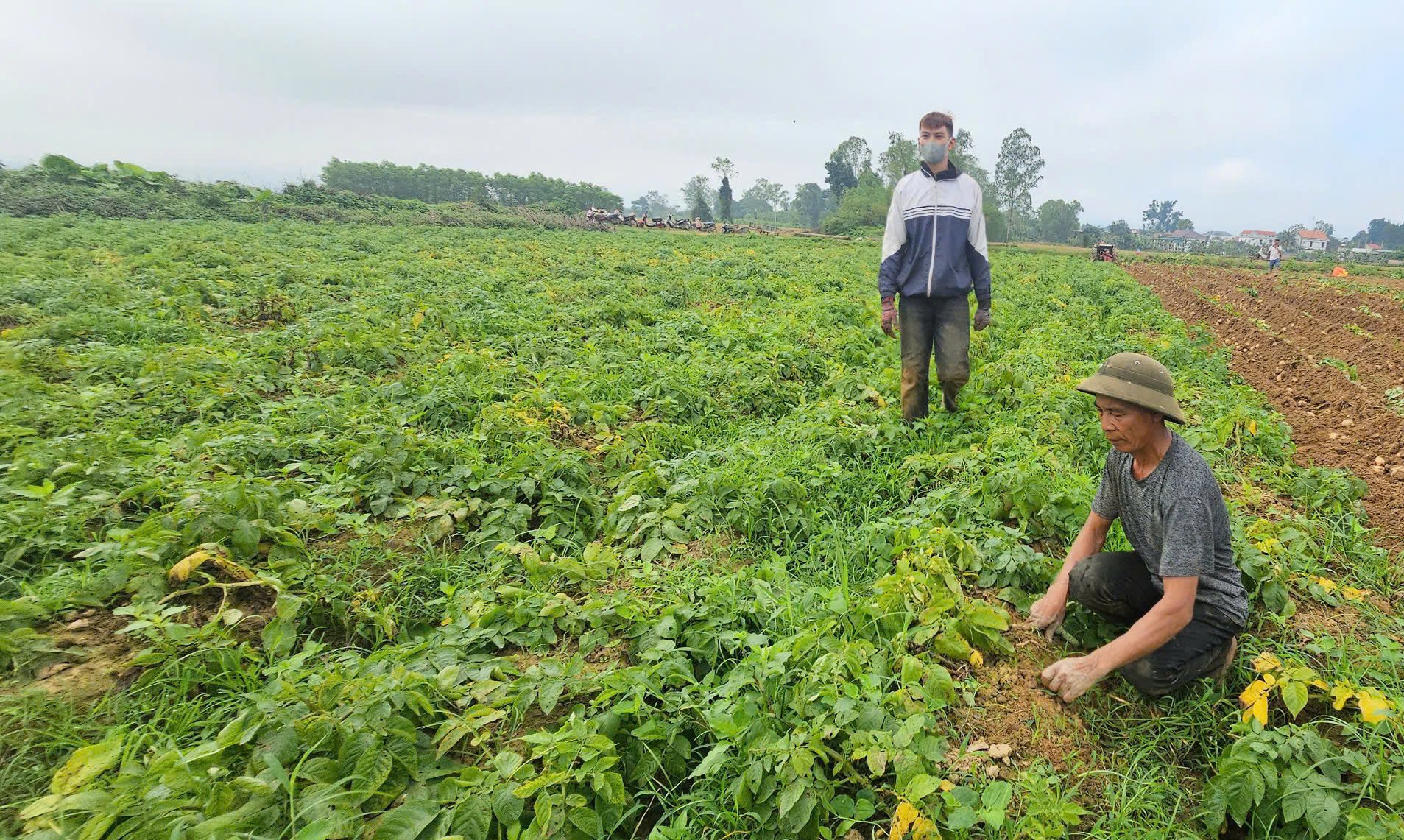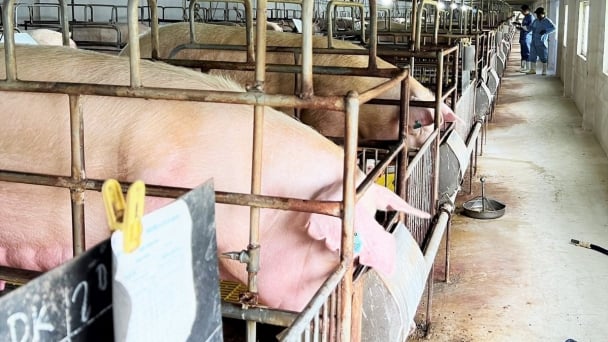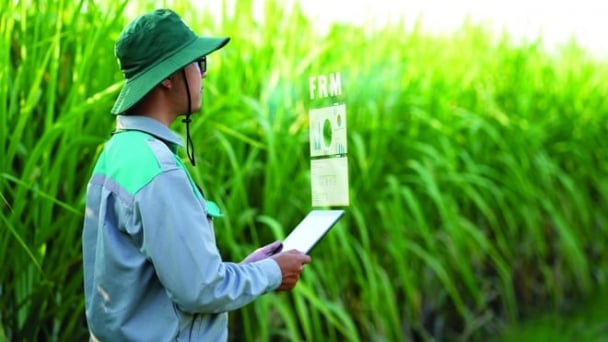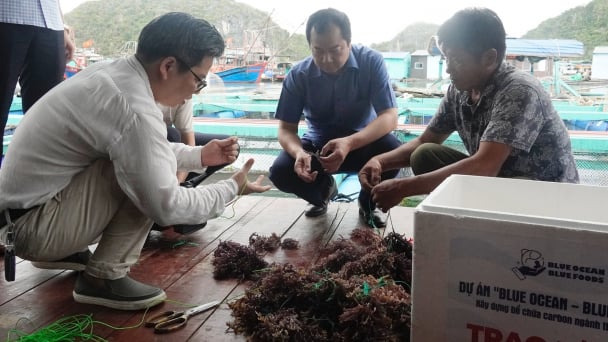May 25, 2025 | 22:17 GMT +7
May 25, 2025 | 22:17 GMT +7
Hotline: 0913.378.918
May 25, 2025 | 22:17 GMT +7
Hotline: 0913.378.918
In the context of climate change and the increasing severity of natural conditions, the development of sustainable and efficient agricultural models has become one of the crucial strategies to improve the livelihoods of local people.
According to Associate Professor Dr. Nguyen Xuan Truong, Director of the Institute of Agricultural Biology at the Vietnam National University of Agriculture, one of the most remarkable models currently being implemented is growing potatoes on sandy soil in Ly Nam commune, Bo Trach district, Quang Binh province.
"After experimenting with planting 'White' potatoes in various seasons on sandy land, the winter-spring crop season produced unexpected results, bringing significant income to the farmers", said Dr. Truong.

The potato cultivation model on the sandy soil of Quang Binh. Photo: T. Phung.
The experimental model of potato cultivation in the sandy regions of Quang Binh is being led by the Institute of Agricultural Biology, with the An Nong Agricultural Cooperative collaborating with three households to carry out the project. The initiative is financially supported by KOICA (Korea International Cooperation Agency).
According to Mr. Nguyen Xuan Truong, introducing potatoes to the sun-drenched and windy land of Quang Binh was a difficult challenge. Potatoes are typically grown in more favorable climates such as the Red River Delta, the northern mountainous areas, or the Central Highlands.
“We’ve experimented with various models across different lands in Quang Binh province, testing them at different times of the year to determine the most advantageous planting schedule. The best approach has been to plant potatoes at the end of the year and harvest them at the beginning of the following year. During this time, Quang Binh experiences a lot of rain and cooler temperatures, and when spring comes with warmer weather, the harvest is ready", Mr. Truong added.
The model is being implemented on a 1.5-hectare area of sandy soil, which has traditionally been considered difficult to cultivate due to its low water retention and nutrient-holding capacity. However, through the application of advanced agricultural techniques such as soil improvement, the use of appropriate fertilizers, and the selection of potato varieties that are well-adapted to local conditions, the model has demonstrated the potential of sandy soil for agricultural production.
After harvesting, the experimental model of potato cultivation on sandy land achieved an impressive average yield of about 17 tons per hectare. Mr. Nguyen Xuan Truong commented, "The initial results show that this model not only brings high economic efficiency but also opens up substantial opportunities for the local agricultural sector. It helps farmers transition to growing new crops with higher income potential, and there is room to expand the model to other areas".
Additionally, Mr. Truong pointed out that the model has introduced a new way of thinking to local farmers about improving sandy soil. By incorporating organic fertilizers and green manure, farmers are enhancing the soil's ability to retain water and nutrients. This method allows for more sustainable land management, including crop rotation and the use of organic fertilizers to improve soil fertility and reduce pest issues in future crop cycles. Moreover, the demand for potatoes in Vietnam is growing, especially in the food processing industry. This opens up vast opportunities for local farmers to sell their products, contributing to the development of a sustainable agricultural economy.

Mr. Vo Van Son shared, "Introducing potatoes to the sandy soil opens up a new direction for local farmers to increase their income". Photo: Viet Khanh.
On a field beside a wide concrete road in Dong Thanh village, Mr. Vo Van Son's family is busy harvesting potatoes. Taking a break, Mr. Son shared that this land was previously used for growing cassava, which has a long growing period of over 9 months and allows for only one harvest per year.
In recent years, the KM94 cassava variety grown by local farmers has been severely affected by leaf spot disease, leading to low yields. As a result, farmers only earned about 50-60 million VND per hectare, with minimal profit left. Mr. Son’s family decided to join the potato cultivation model, planting on an area of about 5 sao (500 m² per sao). “The project provided us with seeds, fertilizers, and production guidelines, which made the process much easier. Growing potatoes isn’t as challenging as traditional crops. Over the course of three months, the potato plants thrived, and we didn’t notice any pests, so everyone is very happy with the results", Mr. Son explained.
In the field, Mr. Son’s son, Anh Chinh, was driving a plow along the potato rows, turning the soil. After each row was plowed, round, plump potatoes popped up from the earth and lay exposed on the surface. Mr. Son and several local women were carefully gathering the potatoes and arranging them into neat rows on the field.
With his land, Mr. Son quickly calculated that after harvesting, the yield reached approximately 4.8 tons of potatoes. The company purchased the potatoes at the farm gate price of 8,500 VND per kilogram, generating a revenue of over 39 million VND. "After deducting costs such as seeds, fertilizers, and other expenses, I made a profit of nearly 20 million VND. This profit is comparable to the income we earn from cultivating one hectare of cassava. For the next season, my family plans to convert about one hectare of cassava land into potato cultivation to increase our income", Mr. Son shared with satisfaction.
Mr. Vo Van Toan, who is also participating in the winter-spring potato cultivation model on nearly one hectare of land, reported that the colder, more temperate weather towards the end of the year created ideal growing conditions for the potatoes, resulting in a high yield. "My land produced about 17-18 tons of potatoes. After subtracting all expenses, I was left with approximately 80 million VND in profit. This is unusually high profit compared to other crops", Mr. Toan said.
According to Mr. Toan, another key advantage of the potato farming model is the ability to quickly prepare the soil for the next crop after harvesting. Farmers can apply fertilizer and start planting crops such as watermelon for the spring-summer season or sow green beans, sesame, or other short-cycle crops. The ability to switch crops has allowed farmers to practice crop rotation, giving them more harvests and enhancing their overall income.
"If we grow cassava, it takes about 9-10 months to harvest. Meanwhile, with potatoes, we can rotate crops with watermelon, beans, and sesame, giving the land time to rest. In this way, on the same land, we can rotate at least three crops a year, significantly increasing our income. Plus, the frequent use of fertilizers enriches the soil, improving its fertility", Mr. Toan added.
Many farmers in the area have visited the winter-spring potato cultivation model to learn from the experience and consider switching their crop structure. Mr. Le Van Tan, from Ly Nam commune, calculated that if a farmer had one hectare of potatoes, followed by a watermelon crop, and then beans or other crops, they could easily earn hundreds of millions of VND annually from their fields.
Mr. Doan Ngoc Nhan, Vice Chairman of the People's Committee of Ly Nam Commune, observed that with the promising results from the 1.5-hectare experimental plot, many experts believe that the potato cultivation model on sandy soil in Quang Binh can be expanded to other areas with similar natural conditions. "Currently, our locality has 1,200 hectares of sandy soil that could be used to expand the winter-spring potato cultivation model", Mr. Nhan said.
$ 1 = VND 25.435 - Source: Vietcombank.
Translated by Phuong Linh
/2025/05/25/4127-3-073637_820.jpg)
(VAN) Thanks to the promotion from an FAO-implemented project, vegetable production in greenhouses in Moc Chau has seen strong development, from 1.5 hectares in 2021 to nearly 50 hectares in 2024.

(VAN) FAO has recently supported USD 140,000 to implement the project 'Risk mitigation human-animal interface risks through disease control initiatives in pig farming.'

(VAN) The People's Committee of Tra Vinh province has approved an adjustment to the investment policy for the Green Hydrogen Plant project, increasing its area to approximately 52.76 hectares.
![Reducing emissions from rice fields: [2] Farmers’ commitment to the soil](https://t.ex-cdn.com/nongnghiepmoitruong.vn/608w/files/news/2025/05/05/dsc08881jpg-nongnghiep-140632.jpg)
(VAN) Clean rice cultivation model in Thuong Tan commune, Bac Tan Uyen district, is assisting local residents in achieving sustainable agriculture by substantially reducing costs, increasing productivity, and protecting the environment.

(VAN) At the conference to disseminate Resolution No. 68, AgriS introduced its digital agricultural ecosystem and reaffirmed its commitment to accompanying the Government in promoting private sector development and sustainable agriculture.

(VAN) 'Blue Ocean - Blue Foods' initiative is designed to restore marine ecosystems and establish sustainable livelihoods for local communities by cultivating a minimum of 1,000 hectares of cottonii seaweed in the first three years.
/2025/05/21/4642-3-112707_603.jpg)
(VAN) The V-SCOPE project has made direct contributions to three out of six pillars of the Comprehensive Strategic Partnership between Vietnam and Australia.